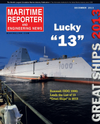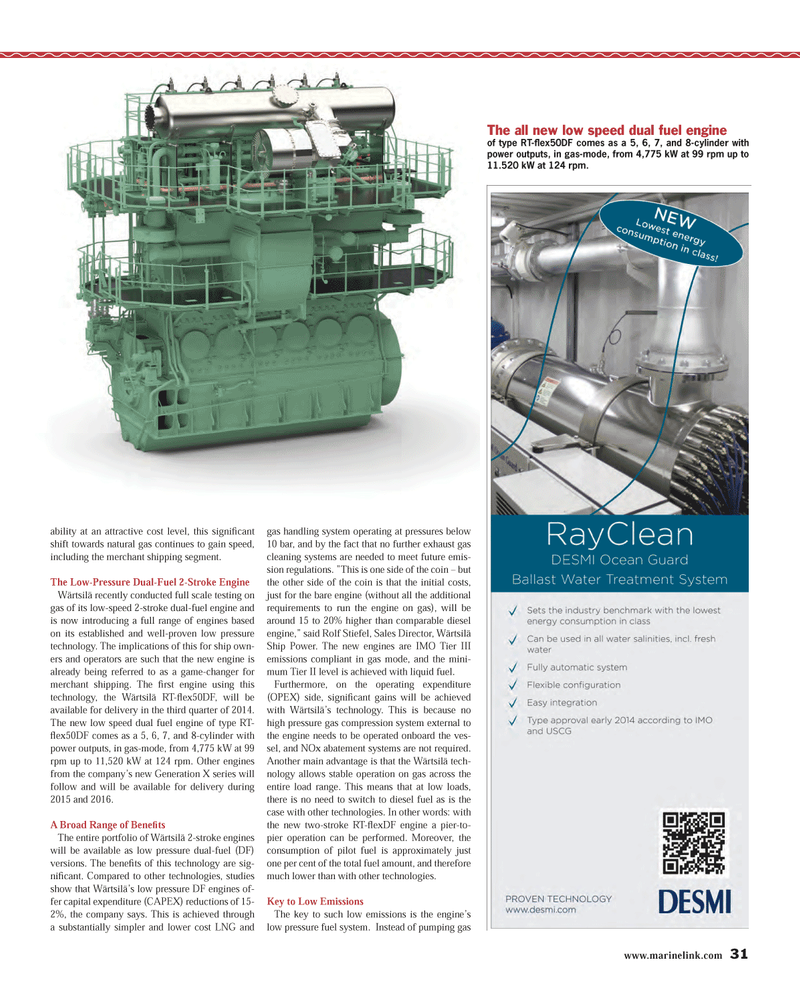
Page 31: of Maritime Reporter Magazine (December 2013)
Great Ships of 2013
Read this page in Pdf, Flash or Html5 edition of December 2013 Maritime Reporter Magazine
www.marinelink.com 31ability at an attractive cost level, this signiÞ cant shift towards natural gas continues to gain speed, including the merchant shipping segment.The Low-Pressure Dual-Fuel 2-Stroke Engine Wärtsilä recently conducted full scale testing on gas of its low-speed 2-stroke dual-fuel engine and is now introducing a full range of engines based on its established and well-proven low pressure technology. The implications of this for ship own-ers and operators are such that the new engine is already being referred to as a game-changer for merchant shipping. The Þ rst engine using this technology, the Wärtsilä RT- ß ex50DF, will be available for delivery in the third quarter of 2014. The new low speed dual fuel engine of type RT- ß ex50DF comes as a 5, 6, 7, and 8-cylinder with power outputs, in gas-mode, from 4,775 kW at 99 rpm up to 11,520 kW at 124 rpm. Other engines from the company?s new Generation X series will follow and will be available for delivery during 2015 and 2016. A Broad Range of Bene Þ ts The entire portfolio of Wärtsilä 2-stroke engines will be available as low pressure dual-fuel (DF) versions. The bene Þ ts of this technology are sig-niÞ cant. Compared to other technologies, studies show that Wärtsilä?s low pressure DF engines of- fer capital expenditure (CAPEX) reductions of 15-2%, the company says. This is achieved through a substantially simpler and lower cost LNG and gas handling system operating at pressures below 10 bar, and by the fact that no further exhaust gas cleaning systems are needed to meet future emis-sion regulations. ?This is one side of the coin ? but the other side of the coin is that the initial costs, just for the bare engine (without all the additional requirements to run the engine on gas), will be around 15 to 20% higher than comparable diesel engine,? said Rolf Stiefel, Sales Director, Wärtsilä Ship Power. The new engines are IMO Tier III emissions compliant in gas mode, and the mini-mum Tier II level is achieved with liquid fuel. Furthermore, on the operating expenditure (OPEX) side, signiÞ cant gains will be achieved with Wärtsilä?s technology. This is because no high pressure gas compression system external to the engine needs to be operated onboard the ves-sel, and NOx abatement systems are not required. Another main advantage is that the Wärtsilä tech- nology allows stable operation on gas across the entire load range. This means that at low loads, there is no need to switch to diesel fuel as is the case with other technologies. In other words: with the new two-stroke RT- ß exDF engine a pier-to- pier operation can be performed. Moreover, the consumption of pilot fuel is approximately just one per cent of the total fuel amount, and therefore much lower than with other technologies. Key to Low EmissionsThe key to such low emissions is the engine?s low pressure fuel system. Instead of pumping gas The all new low speed dual fuel engine of type RT-ß ex50DF comes as a 5, 6, 7, and 8-cylinder with power outputs, in gas-mode, from 4,775 kW at 99 rpm up to 11.520 kW at 124 rpm.MR #12 (26-33).indd 31MR #12 (26-33).indd 3112/2/2013 3:34:16 PM12/2/2013 3:34:16 PM

 30
30

 32
32
